FAQs
What is Hands-Only CPR?
Hands-Only CPR is vital for a bystander to start immediately after calling 911 when a teen or adult experiences out-of-hospital Sudden Cardiac Arrest, and is suddenly unresponsive, until the ambulance arrives. It is composed of chest compression only at least 2″ deep at the speed of 100-120 chest compressions per minute, no rescue breaths.
When I last took a CPR Course, I had to worry about breathing. Why are you not teaching rescue breathing now?
Research has shown that Hands-only CPR without rescue breathing can be just as effective in helping the patient survive in the time it takes for trained help arrives after calling 911 as traditional CPR including rescue breaths. Since Hands-only CPR was introduced, chances of a bystanders immediately helping, in a sudden incident of unresponsiveness, doubled and tripled!
Why should I learn compression only CPR?
350,000 lives are effected by Sudden Cardiac Arrest every year. Compression-only CPR is easy to learn, and effective in helping save lives of these thankful patients.
Chances of survival rise from 10% in most places to up to 60% in places like Seattle and Casinos where survival is double or triple. Those in Seattle initiated widespread knowledge and quick utilization of Hands-only CPR, and the widespread placement of AED devices. In Casinos, chest compression is started immediately and an AED arrives within minutes to shock the heart back to normal. As we can see by these examples, starting hands-only CPR immediately has been shown triple the patients chances of making it to the hospital to receive medical attention that could potentially save their life.
What if they don’t need CPR and I hurt them?
You will not harm a person as they will likely wake up as soon as you start compression on their chest if they are not unconscious. It is important that you aggressively shake the person for a few seconds, if they do not respond begin chest compression immediately.
What is Sudden Cardiac Arrest?
Sudden Cardiac Arrest is a condition where the heart goes into a deadly, irregular heart beat. It is unable to pump oxygenated blood to the vital organs, so this is were you come in with compression-only CPR. You act as the heart and pump the blood to their vital organs with chest compression. “Be their heart, with hands-only CPR”
Will I get sued?
The Good Samaritan law protects you from any liability if you perform CPR. In New Mexico, the law also protects the use of a automated external defibrillator (AED) thanks to initiation by Dr. Ramo with the NM Heart Institute Foundation. We also cover use of an AED in our program, since anyone can now use one to shock the heart into a normal rhythm.
When is your training offered?
Request a training for your family or organization anytime!
Project Heart Start Day: The New Mexico Heart Institute Foundation together with volunteer planning committees from across the state organizes an annual NM Project Heart Start Day.
How much does it cost?
There is no charge for public Project Heart Start training. Donations to the New Mexico Heart Institute Foundation are appreciated to help us continue our efforts.
How long does the training take?
Since it is not a certification program, training is done within 1 hour. We encourage doing as much training as possible.
Is this a certification course?
Project Heart Start training is not a certification program. If you or your group needs to be CPR certified, please refer to organizations like the American Heart Association or the American Red Cross.
